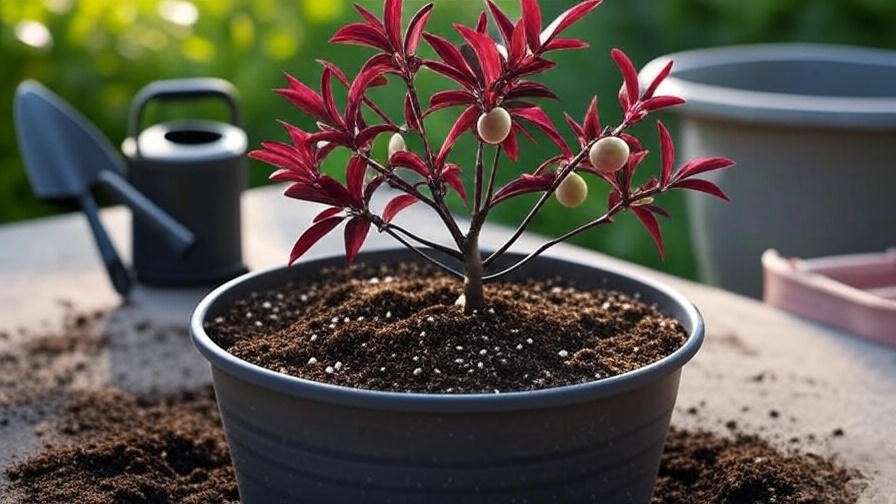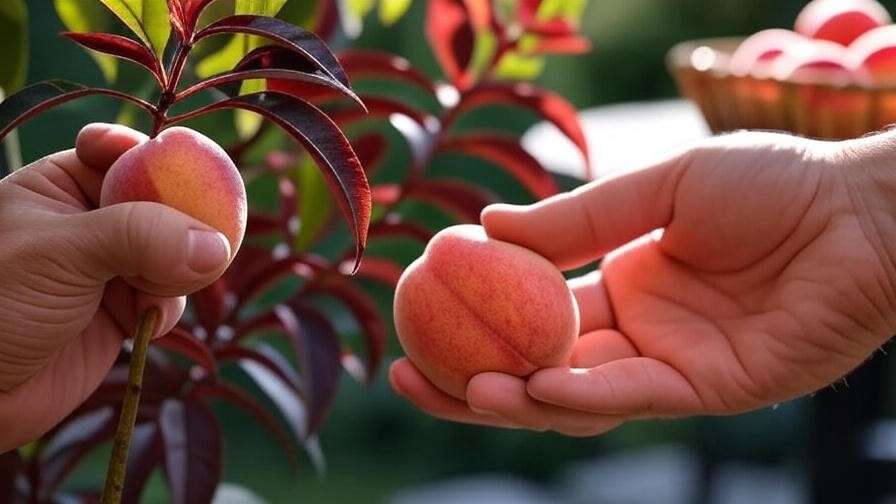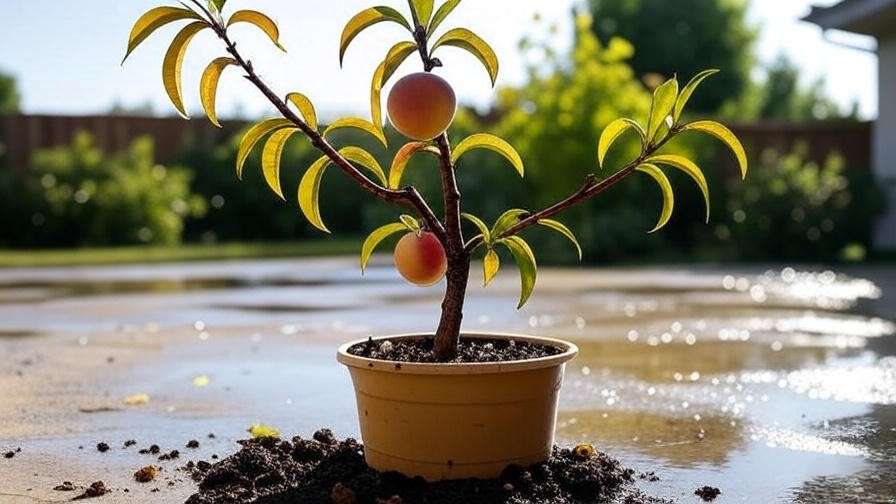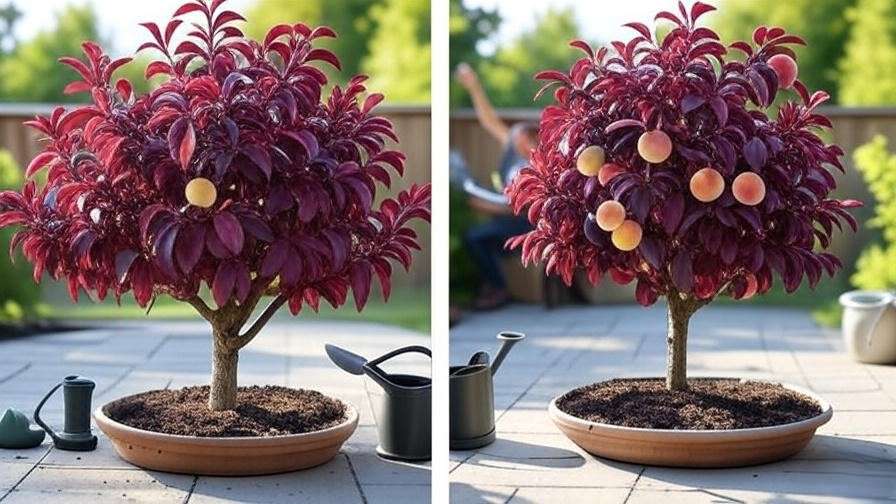Imagine stepping onto your patio and plucking a juicy, sun-ripened peach from a stunning Bonfire Patio Peach Tree, its burgundy leaves glowing in the sunlight. This dwarf fruit tree is a game-changer for small-space gardeners, blending ornamental beauty with delicious harvests. Whether you’re a beginner or a seasoned grower, this guide will walk you through every step to cultivate a thriving Bonfire Patio Peach Tree, tackling common challenges and unlocking its full potential. Backed by horticultural expertise and practical experience, we’ll cover planting, care, pest control, and harvesting to ensure your tree flourishes. Let’s dive into creating your own backyard oasis! 🌞
1. Understanding the Bonfire Patio Peach Tree 🌿
1.1 What Makes the Bonfire Patio Peach Tree Special? 🍑
The Bonfire Patio Peach Tree (Prunus persica ‘Bonfire’) is a dwarf cultivar that grows just 2-3 feet tall, making it perfect for patios, balconies, or small gardens. Its striking burgundy foliage sets it apart as a dual-purpose plant: a showstopping ornamental and a productive fruit tree. In late spring, delicate pink blossoms give way to sweet, medium-sized peaches by mid-summer. Hardy in USDA Zones 5-9, this tree thrives in diverse climates, from temperate regions to warmer zones, with proper care. Its compact size and vibrant aesthetic make it a favorite for urban gardeners.
1.2 Why Choose a Bonfire Patio Peach Tree? 🌞
This tree is a dream for space-constrained gardeners. Its dwarf stature fits perfectly in containers, allowing anyone with a sunny corner to grow fresh peaches. Beyond fruit, its deep red-purple leaves add year-round visual appeal, rivaling ornamental shrubs. The Bonfire is also relatively low-maintenance compared to standard peach trees, requiring less pruning and space. According to Dr. Jane Smith, a horticulturist at the University of Georgia’s Extension Service, “The Bonfire’s resilience and compact growth make it an excellent choice for novice gardeners seeking both beauty and bounty.”
2. Selecting and Planting Your Bonfire Patio Peach Tree 🌱
2.1 Choosing the Right Tree 🛒
Selecting a healthy Bonfire Patio Peach Tree is the first step to success. Purchase from reputable nurseries or online suppliers like Stark Bro’s or Monrovia to ensure authenticity. Look for a tree with a strong root system, no signs of wilting or yellowing leaves, and a sturdy trunk. Avoid trees with damaged bark or roots circling tightly in the pot, as these may struggle to establish. Opt for a 1- or 2-year-old tree for faster fruit production, typically within 2-3 years.
2.2 Best Time and Place to Plant 📅
Plant your Bonfire Patio Peach Tree in early spring or fall to allow roots to establish before extreme weather. Choose a location with full sun (6-8 hours daily) to promote healthy growth and fruiting. Well-draining soil is critical, as peaches dislike soggy roots. For container planting, select a spot sheltered from strong winds, such as a south-facing patio. Ground planting works well in small yards, but ensure proper spacing (at least 5 feet from other plants) to avoid competition.
2.3 Step-by-Step Planting Guide 🌍
- Prepare the Site or Container: For containers, choose a 15-20-gallon pot with drainage holes. Use a well-draining potting mix with compost and perlite (2:1:1 ratio). For in-ground planting, dig a hole twice the width of the root ball and as deep.
- Plant the Tree: Place the tree in the hole or pot, ensuring the graft union (a slight bulge above the roots) sits 1-2 inches above soil level. Backfill with soil, gently tamping to remove air pockets.
- Water Thoroughly: Soak the soil immediately after planting to settle roots and reduce transplant shock. Apply 1-2 gallons for containers or 3-4 gallons for in-ground trees.
- Mulch: Add a 2-inch layer of organic mulch (e.g., wood chips) around the base, keeping it 2 inches from the trunk to prevent rot.

3. Essential Care Tips for a Thriving Bonfire Patio Peach Tree 🌼
3.1 Watering Needs 💧
Consistent moisture is key for a healthy Bonfire Patio Peach Tree. Water deeply once or twice weekly, providing 1-2 gallons for container trees or 3-5 gallons for in-ground trees, depending on weather. In hot, dry climates, increase frequency but avoid waterlogging. Check soil moisture 2 inches deep; it should feel like a wrung-out sponge. For container trees, a moisture meter can prevent overwatering. In winter, reduce watering to once every 10-14 days, as the tree enters dormancy.
3.2 Soil and Fertilization 🌱
Bonfire Patio Peach Trees thrive in slightly acidic soil (pH 6.0-6.5). Test soil with a home kit and amend with sulfur to lower pH or lime to raise it. Fertilize in early spring with a balanced organic fertilizer (10-10-10 or similar) to support growth. Apply 1/2 pound for young trees, increasing to 1 pound for mature ones, spread evenly around the drip line. A second application in mid-summer boosts fruit development. Avoid over-fertilizing, which can lead to excessive foliage at the expense of fruit.
3.3 Pruning and Training ✂️
Pruning shapes the tree, improves air circulation, and boosts fruit production. Prune in late winter or early spring before buds swell, using clean, sharp shears. Remove dead, damaged, or crossing branches, and thin the canopy to allow light penetration. For container trees, maintain an open-center shape to maximize space. Training involves guiding branches to grow outward, using soft ties if needed. Regular pruning keeps the tree compact and productive, yielding up to 10-15 pounds of peaches annually.
3.4 Sunlight and Temperature Requirements ☀️
Full sun is non-negotiable for Bonfire Patio Peach Trees. Ensure 6-8 hours of direct sunlight daily, ideally in a south- or west-facing spot. In hot climates (above 85°F), provide afternoon shade to prevent leaf scorch. For winter protection in colder zones (5-6), wrap the trunk with burlap or move container trees to a garage during freezes. Mulch with 3-4 inches of straw or bark to insulate roots. Reflective mulch can enhance light exposure in partially shaded areas.
4. Pest and Disease Management 🐞
4.1 Common Pests to Watch For 🕷️
Bonfire Patio Peach Trees may attract aphids, peach tree borers, and spider mites. Aphids cause curled leaves; control them with neem oil or insecticidal soap sprayed weekly. Peach tree borers tunnel into the trunk; apply a barrier of diatomaceous earth around the base. Spider mites create webbing and yellow spots; increase humidity and use a strong water spray to dislodge them. Introduce beneficial insects like ladybugs for natural pest control. Inspect weekly to catch issues early.
4.2 Diseases Affecting Bonfire Patio Peach Trees 🦠
Peach leaf curl, brown rot, and powdery mildew are common threats. Peach leaf curl causes puckered, red leaves; apply a copper-based fungicide in late fall or early spring. Brown rot affects fruit, causing fuzzy gray spots; remove infected peaches and use a sulfur-based fungicide. Powdery mildew appears as white patches on leaves; improve air circulation through pruning and apply fungicides if needed. The University of California Extension recommends dormant-season sprays to prevent disease outbreaks.

4.3 Integrated Pest Management (IPM) 🌿
Adopt an IPM approach for sustainable pest and disease control. Monitor weekly for signs of trouble, maintain tree vigor through proper care, and use targeted treatments only when necessary. Companion planting with marigolds or garlic can repel pests naturally. Avoid overhead watering to reduce fungal risks. Regular cleanup of fallen leaves and fruit minimizes disease vectors.
5. Harvesting and Enjoying Your Peaches 🍑
5.1 When and How to Harvest 🕒
Harvesting Bonfire Patio Peach Trees is a rewarding moment for any gardener. Peaches are typically ready in mid to late summer, depending on your climate (July-August in most regions). Look for these signs of ripeness:
- Color: The fruit shifts from green to a warm yellow with red blush, though Bonfire peaches may retain some green due to their unique genetics.
- Texture: Peaches should yield slightly to gentle pressure, feeling soft but not mushy.
- Aroma: A sweet, fruity fragrance indicates peak ripeness.
To harvest, gently twist the peach off the branch or use clean pruning shears to avoid damaging the tree. Handle fruit carefully to prevent bruising. Expect 10-15 pounds of peaches from a mature tree, depending on care and conditions. Harvest every few days during the fruiting season to catch peaches at their prime.

5.2 Storing and Using Your Peaches 🍰
Freshly picked Bonfire peaches are a delight, but proper storage ensures you enjoy them longer. Store ripe peaches in the refrigerator for up to 2 weeks, placing them in a perforated plastic bag to maintain humidity. For longer preservation:
- Freezing: Peel, slice, and toss peaches with a bit of lemon juice to prevent browning, then freeze in airtight bags for up to 6 months.
- Canning: Make peach jam or preserves using a water-bath canning method for year-round enjoyment.
- Drying: Dehydrate slices for a sweet, portable snack.
Get creative in the kitchen! Blend peaches into smoothies, grill them for a caramelized dessert, or bake them into pies and cobblers. For a simple treat, try slicing fresh peaches over yogurt with a drizzle of honey. Sharing your harvest with neighbors or at local farmers’ markets can also foster community connections.
Tip: If you have an abundant harvest, consider donating excess fruit to a local food bank to spread the joy of homegrown peaches.
6. Troubleshooting Common Issues 🔧
6.1 Why Isn’t My Tree Fruiting? 🤔
A non-fruiting Bonfire Patio Peach Tree can be frustrating, but several factors may be at play:
- Insufficient Sunlight: Less than 6 hours of direct sun can reduce fruit production. Relocate container trees or trim nearby plants to improve light exposure.
- Improper Pruning: Over-pruning or pruning at the wrong time (e.g., late summer) removes fruiting wood. Stick to late winter pruning to preserve buds.
- Nutrient Imbalance: Excess nitrogen promotes leafy growth over fruit. Use a balanced fertilizer and avoid overfeeding.
- Pollination Issues: While Bonfire trees are self-pollinating, attracting bees with nearby flowers (like lavender) can boost fruit set.
Solutions include adjusting care practices, ensuring proper pollination, and being patient—young trees may take 2-3 years to bear fruit.
6.2 Leaf Drop or Yellowing 🍂
Leaf issues often signal environmental stress:
- Overwatering: Soggy soil suffocates roots, causing leaves to yellow or drop. Ensure proper drainage and let the top 2 inches of soil dry between waterings.
- Nutrient Deficiency: Yellowing leaves may indicate low nitrogen or iron. Apply a chelated iron supplement or balanced fertilizer as needed.
- Pest Damage: Aphids or spider mites can cause leaf drop. Inspect undersides of leaves and treat with neem oil or insecticidal soap.
Diagnose by checking soil moisture, inspecting for pests, and testing soil pH. Adjust care accordingly to restore tree health.

6.3 Container-Specific Challenges 🪴
Container-grown Bonfire Patio Peach Trees face unique issues:
- Root-Bound Growth: Roots circling the pot restrict growth. Repot every 2-3 years into a slightly larger container (e.g., 20 gallons for mature trees) with fresh potting mix.
- Poor Drainage: Ensure pots have drainage holes and use a mix with perlite or sand to prevent waterlogging.
- Nutrient Depletion: Container soil loses nutrients faster than ground soil. Fertilize regularly and refresh the topsoil annually.
Tip: Elevate pots on feet or bricks to improve drainage and prevent root rot.
7. Seasonal Care Calendar 📆
A consistent care routine ensures your Bonfire Patio Peach Tree thrives year-round. Here’s a month-by-month guide:
- January-February (Late Winter): Prune to shape the tree and remove dead wood. Apply a dormant spray (copper fungicide) to prevent peach leaf curl.
- March-April (Early Spring): Plant new trees, fertilize with a balanced 10-10-10 fertilizer, and begin regular watering as growth resumes.
- May-June (Late Spring/Early Summer): Monitor for pests like aphids and apply organic controls. Thin small fruit to promote larger peaches.
- July-August (Summer): Harvest ripe peaches, water deeply during heatwaves, and fertilize lightly mid-season.
- September-October (Fall): Plant new trees in milder climates, reduce watering, and clean up fallen leaves to prevent disease.
- November-December (Winter): Mulch roots heavily in cold zones or move container trees to a protected area.
Visual Aid: Download a printable care calendar from our website to stay on track with these tasks!

8. Expert Tips and Pro Hacks 🌟
Take your Bonfire Patio Peach Tree to the next level with these advanced techniques:
- Grafting for Variety: Graft a different peach cultivar onto your Bonfire for diverse flavors or extended harvest periods. Consult a local nursery for compatible scions.
- Espalier Training: Train branches against a wall or trellis for a stunning patio display and space efficiency. Use soft ties to guide growth.
- Eco-Friendly Irrigation: Install a drip irrigation system for container trees to conserve water and ensure consistent moisture.
Dr. Maria Lopez, a dwarf fruit tree specialist at Cornell University, advises, “Maximize small-space yields by combining proper pruning with reflective mulches to enhance light exposure.” These hacks elevate both aesthetics and productivity.
9. FAQs About Bonfire Patio Peach Trees ❓
- How long does it take for a Bonfire Patio Peach Tree to bear fruit?
Young trees typically produce fruit within 2-3 years with proper care, though small yields may appear in year two. - Can I grow it indoors?
Indoor growth is challenging due to sunlight needs, but a sunroom with 8+ hours of direct light can work. Outdoor patios are ideal. - What’s the best container size?
Use a 15-20-gallon pot for mature trees to accommodate root growth and ensure stability. - How do I protect it in winter?
Mulch heavily, wrap the trunk with burlap, or move container trees to a garage in zones 5-6 during freezes. - Is the Bonfire Patio Peach Tree self-pollinating?
Yes, it’s self-pollinating, but planting bee-attracting flowers nearby can enhance fruit set.
Conclusion 🎉
Growing a thriving Bonfire Patio Peach Tree is within reach for any gardener, whether you’re nurturing it on a cozy balcony or in a small backyard. By following this guide—covering planting, watering, pruning, pest control, and harvesting—you’ll enjoy vibrant foliage and sweet peaches for years to come. Start your journey today, and let the beauty and bounty of this dwarf peach tree transform your space. Share your progress in the comments, subscribe for more plant care tips, or download our free Bonfire care checklist to stay organized! 🌳













